The Wondrous World of Ikat at the Seattle Art Museum until May 29
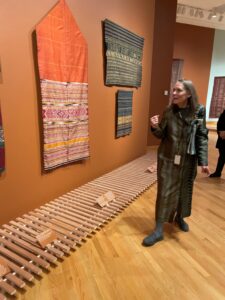
Curator Pamela McCluskey lecturing about a man’s sash or woman’s head cloth, 19th century from Myanmar
Curator Pamela McCluskey began the tour of her dazzling new “Ikat” exhibition at the Seattle Art Museum by pointing out that almost all the clothes we wear are made from oil based polyester with toxic dyes.
“Ikat” celebrates cotton, harvested and dyed by hand in a technique used for centuries. Ikat means binding, and it refers to a specific technique of binding sections of cotton to resist dying during weaving.
I was skeptical of the exhibition at first because I am not at all familiar with textiles. I thought it might be boring! I couldn’t have been more mistaken! The exhibition is riveting in so many ways, that I have been three times, and still haven’t nearly absorbed everything.
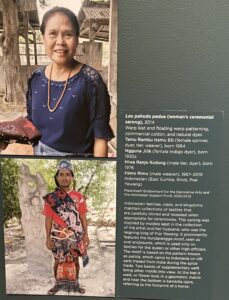
Before you enter the exhibition watch one of the videos of contemporary weavers in Indonesia and look at the work in the adjoining gallery; they provide insights into the gathering of the sources of the dyes in the jungle, the process of preparing the yarn, and the weaving, particularly featuring Tamu Rambu Hamueti queen of the Prai Yawang kingdom on the island of Sumba, Indonesia.
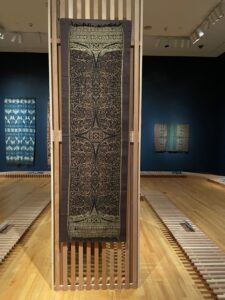
Ritual cloth (geringsing), 20th century Collection of David and Marita Paly Cotton, double ikat 72 × 32 in.
We also begin to learn of the ritual, mythological and symbolic meanings of the textiles, particularly the “geringsing,” a ritual cloth for coming of age girls.
But each of these textiles has a deep spiritual significance. As one weaver explained:
“The spiritual force in natural dyed cloth is amazing. Sometimes people feel as if the cloth has a soul, as if it is alive.”
—Madi Diavi, dyer and weaver in Bali, from the “Touching the Ground” documentary, 2021
The historic textiles in the exhibition are all anonymous, so this contemporary gallery provides an invaluable opportunity to more fully understand the role of Ikat in these cultures.
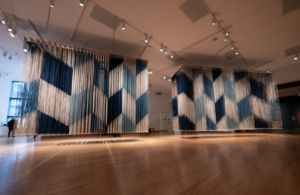
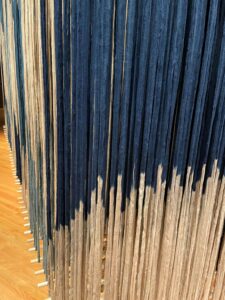
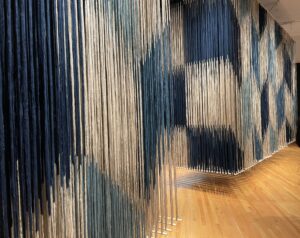
In the main entry to the exhibition we see a spectacular contemporary art work that blows up the technique itself to a huge scale. Zurash/Slipped took artists Chinami and Rowland Ricketts an entire year to complete. The process involves special organic cotton, here in over one thousand bundles bound to resist the dye. The pattern emerges only in the weaving process. Zurash/Slipped has a stepped (slipped) pattern, but the installation is like a giant loom ( 6000 verticals) of 200,00 warp yarn
strands
For the historic textiles, galleries have been entirely transformed: each region is a different color and the fabrics on the wall are now protected not by plexiglass, but by sinuous wooden platforms that prevent us from getting too close.
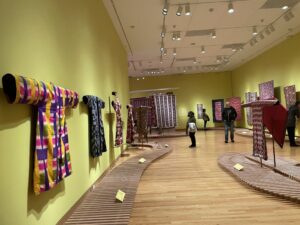
The regions and colors in the order we walk through them are
Japan gray blue
Africa raspberry red
India mustard
Southeast Asia Cinnamon
Uzbekisan lime green ( above)
Indonesia dark blue
Europe pale blue
Americas pink
Contemporary US white (!) and
Contemporary Ikat dark gray
Another helpful aspect of the exhibition is what the museum calls “living labels” short videos in each region that provide more insights into the process by contemporary weavers.
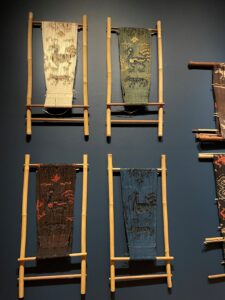
Indonesian looms
These historic fabrics require us to immerse ourselves in their complex patterns and meanings.
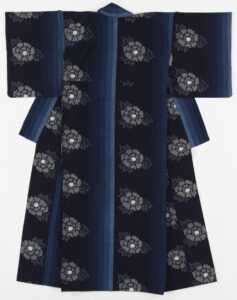
Kimono, 20th century, Japan, Paly Collection
Also crucial to remember is that they originally were an active part of life, as a kimono in Japan, or a ceremonial robe in Africa worn as a political statement in opposition to British colonialism. Here we see the textile immobilized as a flat shape on the wall. It was usually worn by someone in movement
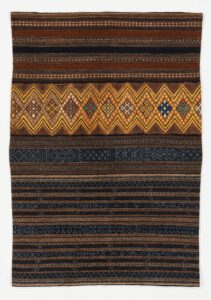
Woman’s Sarong Hainan Island, China
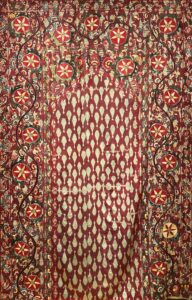
Pardah hanging, late 19th century, Silk Road (Uzbekistan), silk, warp ikat, cotton weft, 90 x 65 in., Collection of David and Marita Paly
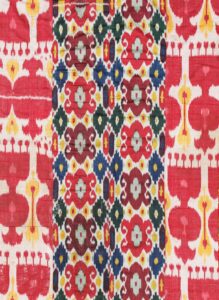
Uzbek Pardah hanging, late 19th century Collection of David and Marita Paly Silk warp ikat, cotton weft 61 × 45 in.
In Uzbekistan Ikat weaving filled the houses as carpets on floors, walls, pillows, and room screens. Women laboriously raised the silkworms for the weavings themselves.
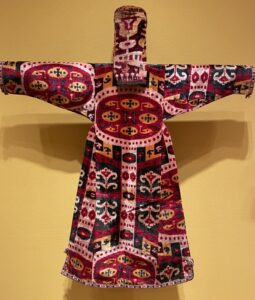
Uzbek Woman’s coat (Munisak), late 19th century Collection of David and Marita Paly Silk velvet warp ikat, cotton weft, silk embroidered edging 50 × 54 in.
The imagery evokes the flowers, plants, birds and insects of a paradise. The colors all come from natural sources:
red from the madder plant, yellow and green from buds of a Japanese pagoda tree, black from pomegranate peel, magenta from scale insects obtained from galls on pistachio trees, and indigo blue imported from India.
The Uzbek weaving traditions were wiped out by the Soviets, but in recent years have seen a huge revival.
Indonesian Galleries
To quote the wall label:
“Indonesia is a polestar of ikat. Like a vast net supporting Asia’s southeast region, its 17,000 islands are home to many who revere cloth as a means of honoring relationships, old and new, personal and environmental. Indonesian dyers and weavers hold on to difficult, time-consuming processes sanctioned by tradition. Some of these cloths are worn daily, and others are brought out for ceremonies and to assist in times of crisis.”
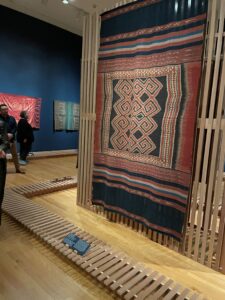
Ritual cloth (pori situtu), early 20th century
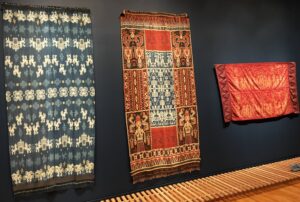
left and center Man’s shawl or hip wrapper (hinggi kawuru), early 20th century;
The Americas are also represented with their own weaving traditions and materials.
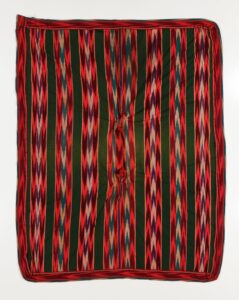
Poncho, 20th century Collection of David and Marita Paly Sheep wool warp ikat 69 × 52 in.
There are even contemporary Ikat examples: artist Polly Barton states:“When tying a knot of resist on thread, this act encodes the thread, locking in the mark of design which carries memory, an historical marker, a global or locally identifiable story which is passed down culturally in the woven membrane or fabric. My own challenge with ikat is when the threads resist, push back, push me forward as an artist while keeping me connected to the web of woven history.”
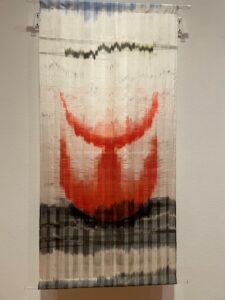
Polly Barton US Prey, from the DARE series, 2017 Silk, double ikat with additional dye, soymilk and sumi ink, 64 1/2 × 31 1/2 in.
This is just a brief taste of an extraordinary exhibition by the amazing curator Pamela McCluskey. She has travelled to Bali several times to meet artists at the “Threads of Life,” an organization that has been helping traditional weaving to survive since 1995.
“Ikat” gives us immersion in a rich tradition. Each of these textiles requires intense viewing to appreciate their process and meaning.
And the next time you buy a garment, think about who made it.
So I end with a plug for Flood my favorite environmentally friendly clothing designer based right here in the Northwest. Their hand made clothing is made from fabrics that are 100% upcycled!
This entry was posted on April 2, 2023 and is filed under Uncategorized.








